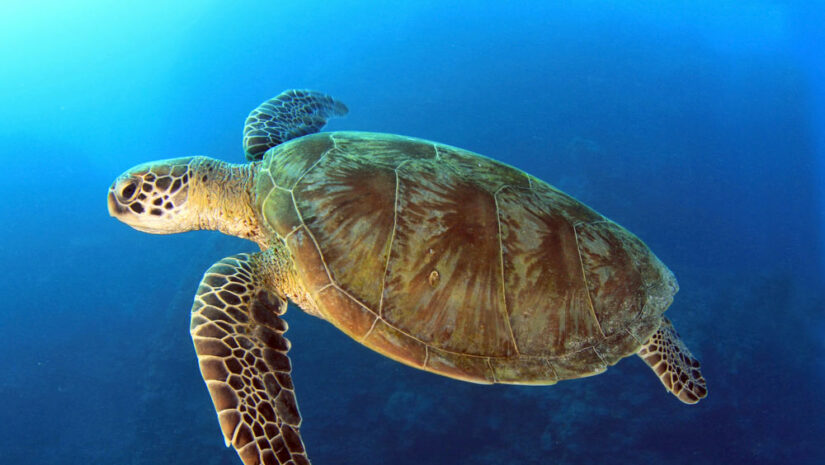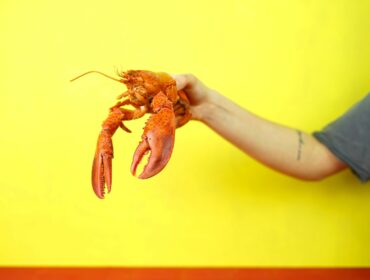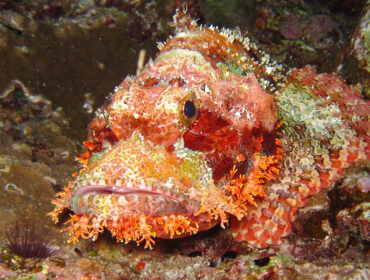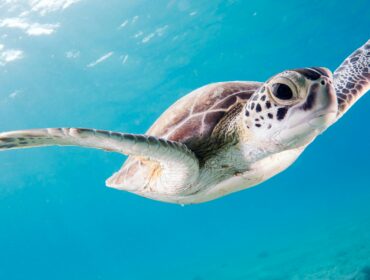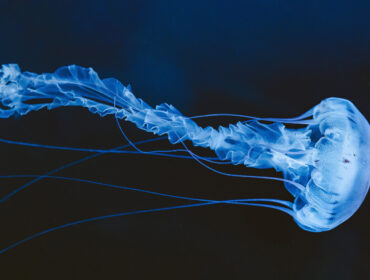Sea turtles have been crawling the Earth and swimming in its oceans for over a hundred million years. These air-breathing reptiles are well adapted to life underwater, only coming ashore to either bask or nest, and spend the bulk of their lives in the ocean. With a life span of 40-60 years, these fascinating marine creatures can swim long distances and dive to great depths, all thanks to their large bodies, hydrodynamic build, and powerful front flippers.
Known as a highly migratory species, sea turtles can be found foraging in almost every ocean throughout the world and nest on tropical and subtropical beaches. Unlike their terrestrial kin, they cannot retract their heads too far into their shells. They have short webbed flippers in place of hind limbs and long narrow wing-like flippers as forelimbs. Their shells consist of an upper shell or the carapace and a lower section called plastron, which are covered with scutes or hard scales like that of lizards and snakes. While these marine reptiles are toothless, their jaws are strong enough to bite, crush, and tear their food.
Different species of sea turtles grace the planet’s waters—namely the hawksbill, loggerhead, leatherback, green turtle, Kemp’s ridley, olive ridley, and flatback. Their sizes vary depending on the species—ranging from the small 75-100 pound Kemp’s ridley to the enormous 1,300 pound, 8-foot-long leatherback turtle.
Sea turtles grow slowly and can take between 15-50 years to reach reproductive maturity, but there is no way to tell their age based on their physical appearance. The smallest species are the ridleys, ranging in size from 85 to 100 pounds as adults, while leatherbacks are giant turtles that can weigh up to 2,000 pounds.
Species of Sea Turtles Native to Florida
Out of the seven sea turtle species in the world, five can be found in Florida:
- Hawksbill Turtles
- Loggerhead Turtles
- Leatherback Turtles
- Green Turtles
- Kemp’s Ridley
Since all five species are considered vulnerable or endangered, they’re protected by the Federal Endangered Species Act of 1973 and Florida’s Marine Turtle Protection Act.
Hawksbill Turtles (Eretmochelys imbricata)

Named for its narrow head, pointed beak, and beautifully colored carapace, the hawksbill is a small and agile sea turtle that is about 30 inches long on average and weighs from 100 to 200 pounds as adults. Its diet consists mainly of sponges and other reef invertebrates, which the hawksbill can easily collect with its raptor-like jaws.
This species is considered to be critically endangered, mainly because of some Asian and European countries that hunt them illegally to make jewelry, hair decorations, and other ornaments out of their striking shells. This is despite the fact that international trade in hawksbill products has been banned in most parts of the world.
Known as the most tropical of the sea turtle species, hawksbills are a highly migratory species and can be seen in the lagoons, reefs, bays, and estuaries of the Indian, Pacific, and Atlantic Oceans. Divers and tourists get frequent sightings of hawksbill turtles off the Florida Keys, and a few nests are documented yearly from the Keys to Canaveral National Seashore.
Loggerhead Turtles (Caretta caretta)

The loggerhead turtle is the most abundant species of sea turtles found in Florida. Named for its bulky, log-shaped head that supports powerful jaw muscles, loggerheads are among the larger sea turtles. They have an average size of 275 pounds as adults and a shell length of approximately three feet.
Each of their flippers has two claws, and their brown and yellow carapace are very broad near the front and narrow towards the rear. Like most sea turtles, the adult male loggerhead has a long tail, while the female loggerhead has a short tail. The gender of juvenile loggerheads, in contrast, cannot be determined externally.
Loggerheads feed on hard-shelled prey like clams, crabs, sea urchins, and other armored animals which they can easily crush with their powerful jaws. Compared to other sea turtles, loggerheads are slow swimmers, but their stamina compensates for their lack of speed. Despite their abundance in most oceans, loggerhead turtles are considered to be a threatened species since they are very prone to fisheries bycatch, which is the accidental capture of marine animals while going after another target species.
Leatherback Turtle (Dermochelys coriacea)

Known for their distinctive look and leather-like shell, leatherbacks are the largest (and perhaps) most unique sea turtle species in the world. An average leatherback turtle is six feet long and weighs from 500 to 1,500 pounds. Some have shattered records, with the largest leatherback on record being almost 10 feet long and weighing over 2,000 pounds.
Unlike other sea turtles that are covered with scales or shields, leatherbacks are covered with a firm, leathery skin in place of a hard shell, with seven distinct ridges running the length down their backs. Leatherbacks have no claws on their flippers and their bodies are usually jet black with white, pink, and blue splotches.
Their diet consists of soft-bodied and slippery prey (such as jellyfish), which the turtles consume using their throat cavity and scissor-like jaws. What’s more, leatherbacks are listed as a vulnerable species as a result of bycatch and excessive egg collection.
As true inhabitants of the deep, leatherbacks have the capacity to dive to a depth of more than 3,000 feet and travel farther than 3,000 miles from their nesting beach. Also a highly migratory species, leatherbacks can be seen throughout the Indian, Atlantic, and Pacific Oceans, and have been spotted as far north as Alaska and Labrador. They can also be found in Florida’s coastal waters.
Researchers have found that leatherbacks have the unique ability to regulate their body temperature, which enables them to tolerate colder waters than any other sea turtle on the planet.
Green Turtle (Chelonia mydas)

What sets the green sea turtle apart from other sea turtle species in Florida is its herbivorous diet. Named for its greenish cartilage and body fat, the green sea turtle has a small head for its size and weighs an average of 350 pounds. Its oval-shaped carapace is around three feet long and is olive-brown with darker streaks, while its plastron is yellow. This species is classified as endangered as they’re often hunted for their meat, hide, eggs, and calipee (the fat attached to the plastron, which is the main ingredient of the popular green turtle soup).
Unique among sea turtles for being largely vegetarian, green turtles primarily feed on seagrasses and algae. They can be found swimming around in shallow flats and seagrass beds during the day and return at sundown to their usual habitats surrounded by oyster bars, coral reefs, and scattered rock ledges. Classified as an endangered species, green turtles are threatened by hunting, bycatch, and the overharvesting of eggs. Each year, about 100 to 1,000 green turtles come ashore to nest on Florida’s beaches from June through late September.
Kemp’s Ridley (Lepidochelys kempi)

Kemp’s ridley is the rarest and most critically endangered sea turtle species in the world, with fewer than a thousand nesting females remaining on Earth. The greatest threat to the survival of Kemp’s ridley are human activities, which include the overharvesting of eggs and killing adults and juveniles for meat and other shell products.
The Kemp’s ridley is a small yet tough sea turtle, measuring from 2 to 2.5 feet long and weighing between 85 to 100 pounds. It has a bony carapace without ridges, and its front and rear flippers are both clawed. Like loggerheads, Kemp ridleys have powerful jaws for crushing and grinding their preferred foods—crabs, clams, mussels, and sea urchins. Aside from armored prey, this species also feeds on fish, squid, jellyfish, shrimp, and other crustaceans. Kemps’ ridley can be found inhabiting shallow areas with sandy and muddy bottoms in Florida’s coastal waters.
Where to See Sea Turtles in Florida

It’s easy to spot sea turtles when diving or snorkelling in Florida’s waters, especially throughout the months of May and September. During this period, over a hundred thousand female sea turtles come ashore to build nest holes and lay their eggs in the sand at nighttime. If you want to see Florida sea turtles in action, it would definitely require some careful planning.
The neighboring beaches of St. Lucie, Brevard, Martin, Indian River, and Palm Beach counties are the most important nesting grounds for loggerhead turtles in Florida, attracting over 15,000 female loggerheads in the months of May through August. If you want to go on an actual turtle tour, many parks and environmental groups offer sea turtle walks during nighttime in June and July. Most of them charge a fee, though some turtle walks are free (but those fill up fast so make sure to book early).
Before the sea-turtle walk program, a talk is required to brief the participants of the guidelines during the tour. You will be with a group of around 20-40 people and accompanied by a turtle walk guide who knows a thing or two about federal and state laws.
Make sure you can walk a mile or more on sand and don’t forget a water bottle, an insect repellent, and of course, a lot of patience! There’s no guarantee that you’ll see a nesting sea turtle, but if you’re lucky enough, you’ll be able to witness lots of them in full glory. Just make sure to watch from a safe distance and follow the rules so you don’t disturb the nesting process and further endanger the lives of sea turtles in Florida.
Here are some popular destinations where you can spot nesting sea turtles in Florida:
- Sea Turtle Preservation Society
- Barrier Island Sanctuary
- Von D. Mizell-Eula Johnson State Park
- John D. MacArthur Beach State Park
- Sebastian Inlet State Park Fishing Museum
When Do Sea Turtles Hatch in Florida?
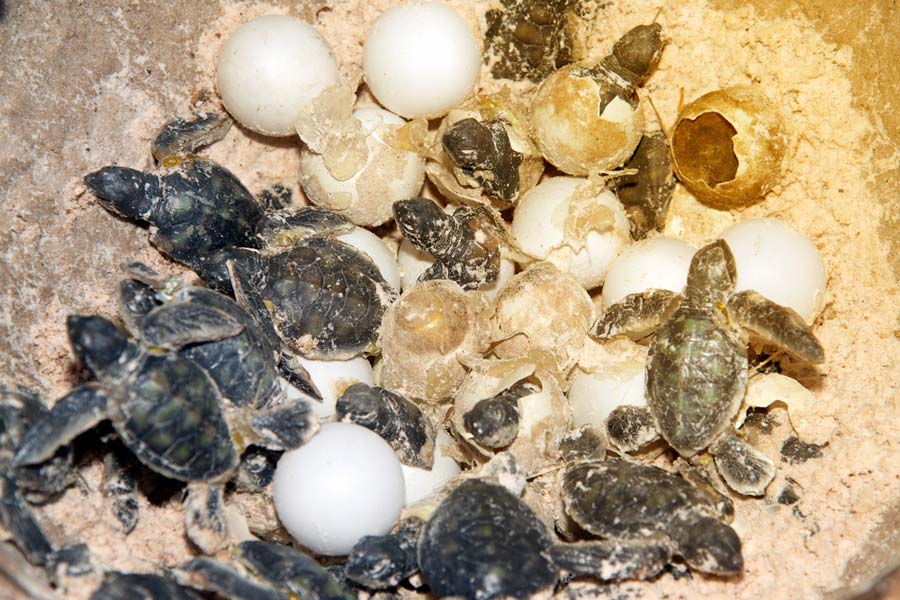
The main nesting months for female sea turtles in Florida runs from March to October. However, leatherbacks are an exception, since they have been observed to start nesting as early as February, and depending on the water temperature, hatchlings emerge well into the winter months.
Fun fact: female sea turtles seem to be weeping as they nest, but the purpose of their tears is to remove the sea salt from their bodies. Female turtles usually reproduce every two to three years and deposit about 80-120 eggs the size of ping-pong balls during nesting season. Once its egg-laying is complete, the female turtle covers the eggs with sand, camouflages the nest hole to keep it away from predators, and returns to the ocean. After two months of incubation, the eggs begin to hatch and the baby sea turtles emerge as a group and venture out into the ocean.
Hatching season usually occurs at night, which is why beachfront communities in Florida have adopted lighting ordinances requiring lights to be shielded or shut off to avoid distracting hatchlings on their way to the ocean. However, only one in a thousand juvenile turtles survive to adulthood. Many die of dehydration or predation unless they make it to the ocean fast enough.
What to Do When You Spot Sea Turtles in Florida

Florida’s beaches are often crowded with people, especially during the summer season when both humans and sea turtles share the sand. Although turtle nesting and hatching usually occurs at night time, it is very likely for people to cross paths with nesting female turtles or hatchlings making their way to the ocean.
Should this happen to you, make sure to keep a safe distance or completely stay out of the sea turtle’s way. Remember that it’s a federal crime to disturb sea turtle nests or harass turtles, so do not get too near, let alone touch or pick up sea turtles, at all costs. Light can also disrupt the nesting process of the female and lead hatchlings away from the water, so refrain from using any flashlights, flash photography, or video equipment.
As an alternative, you can use less intrusive “turtle safe lighting”. These are red lights that emit a very narrow portion of the visible light spectrum. When you spot nesting or hatching sea turtles, leave them and their eggs in their nest and allow the hatchlings to crawl to the water on their own. Take only pictures (without flash) and remember to enjoy the experience from afar.
If you come across a stranded or deceased turtle, a hatchling wandering off in a direction other than the water, or if you catch someone disturbing a nest or sea turtle, call the Florida Fish and Wildlife Conservation Commission (FWC) Division of Law Enforcement at 1-888-404-FWCC or *FWC.
How You Can Help Sea Turtles in Florida
Sea turtles are more than just ancient marine creatures: they contribute to maintaining species diversity, serve as a fundamental link in marine ecosystems, and help maintain the health of seagrass beds and coral reefs.
However, with all species listed as either vulnerable or endangered, sea turtles face an uncertain future. The good news is, you can do a lot of things to aid in their survival. Among the many threats and challenges that sea turtles face are illegal hunting, natural predation, fisheries bycatch, the overharvesting of eggs, water pollution, and coastal urbanization on their nesting beaches.
Here are some ways you can help protect Florida’s sea turtles:
- Organize or participate in beach clean ups
- Do not leave any type of fishing gear on the shore or in the ocean
- Do not try to feed sea turtles
- Never buy products made from sea turtles
- Practice proper waste disposal and reduce plastic usage
- Turn off the beachfront lights and avoid any type of intrusive lighting during nesting season
- Oppose coastal urbanization
- Avoid using too much fertilizer
- Contribute an article to your local newspaper to inform people about the plight of sea turtles and what they can do to help

